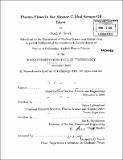| dc.contributor.advisor | Brian LaBombard. | en_US |
| dc.contributor.author | Smick, N. (Noah M.) | en_US |
| dc.contributor.other | Massachusetts Institute of Technology. Dept. of Nuclear Science and Engineering. | en_US |
| dc.date.accessioned | 2010-08-31T16:21:29Z | |
| dc.date.available | 2010-08-31T16:21:29Z | |
| dc.date.copyright | 2009 | en_US |
| dc.date.issued | 2010 | en_US |
| dc.identifier.uri | http://hdl.handle.net/1721.1/57885 | |
| dc.description | Thesis (Ph. D.)--Massachusetts Institute of Technology, Dept. of Nuclear Science and Engineering, February 2010. | en_US |
| dc.description | Cataloged from PDF version of thesis. | en_US |
| dc.description | Includes bibliographical references (p. 227-234). | en_US |
| dc.description.abstract | Near-sonic parallel plasma flows are persistently observed in the scrape-off layer (SOL) of tokamaks, at locations far from material surfaces. Ballooning-like transport asymmetries are thought to be a principal driver for the strong parallel flows, a hypothesis supported by the observation of steep high-field side pressure profiles in double-null discharges. Yet parallel flow can also arise as a result of toroidal plasma rotation and/or neoclassical Pfirsch-Schliiter currents. In addition, the mechanism that closes the mass-flow loop back onto itself has remained elusive. To investigate these phenomena, a novel magnetically-actuated scanning probe has been deployed on the high-field side in Alcator C-Mod. This probe, along with two other scanning probes on the low-field side, measure the total plasma flow vector at these locations: parallel flows, perpendicular E_r x B drifts and radial fluctuation-induced particle fluxes. Boundary layer flows have been systematically examined as magnetic topology (upper versus lower-null) and plasma density were changed. It is found that the plasma flow pattern can be decomposed into two principal parts: (1) a drift-driven component, which lies within a magnetic flux surface and is divergence-free and (2) a transport-driven component which gives rise to parallel flows on the high-field side scrape-off layer. | en_US |
| dc.description.abstract | (cont.) Toroidal rotation, Pfirsch-Schlilter and transport-driven contributions are unambiguously identified. Parallel flows are found to dominate the high-field particle fluxes; the total poloidally-directed flow carries one half of the particle flux arriving on the inner divertor. As a result, convection is also found to be an important player in high-field side heat transport. In contrast, E_r x B plus parallel flows yield a mostly-toroidal flow component in the low-field SOL. The magnitude of the transport-driven flow component is found to be quantitatively consistent with radial fluctuation-induced particle fluxes measured on the low-field side, identifying this as the primary driver. In contrast, fluctuation-induced flux measurements on the high-field side midplane are found to be essentially zero, thereby excluding an 'inward pinch' effect as the mechanism that closes the mass-flow loop in this region. | en_US |
| dc.description.statementofresponsibility | by Noah M. Smick. | en_US |
| dc.format.extent | 234 p. | en_US |
| dc.language.iso | eng | en_US |
| dc.publisher | Massachusetts Institute of Technology | en_US |
| dc.rights | M.I.T. theses are protected by
copyright. They may be viewed from this source for any purpose, but
reproduction or distribution in any format is prohibited without written
permission. See provided URL for inquiries about permission. | en_US |
| dc.rights.uri | http://dspace.mit.edu/handle/1721.1/7582 | en_US |
| dc.subject | Nuclear Science and Engineering. | en_US |
| dc.title | Plasma flows in the Alcator C-Mod scrape-off layer | en_US |
| dc.type | Thesis | en_US |
| dc.description.degree | Ph.D. | en_US |
| dc.contributor.department | Massachusetts Institute of Technology. Department of Nuclear Science and Engineering | |
| dc.identifier.oclc | 641211385 | en_US |
